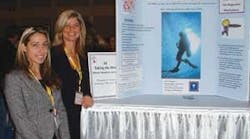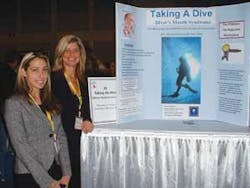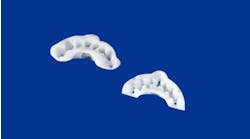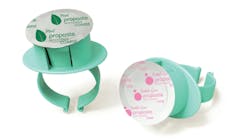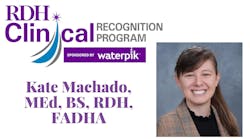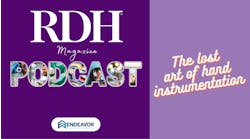by Lory Laughter, RDH, BS
I hear people talk about the science of dental hygiene, but I don't see much science being presented. Those or similar words were delivered at a recent lunch meeting. Part of me wanted to argue and stand up for evidence-based hygienists, but the logical part of me decided to find support for my claim before opening my mouth.
The proof I needed to back my claim that dental hygiene has a science came at the Greater New York Dental Meeting. Winnie Furnari, RDH, MS, assistant professor at New York University, suggested I stop by the student table clinics. She later invited me to join her at the awards ceremony. The students presenting at this meeting were inspiring, intelligent, and very scientific.
Maria Nemelivsky from NYU won first place for her table titled, "Mitochondria are Involved in Phosphate Induced Apoptosis." Her presentation was precise and included all the components of the good science I learned in college. Her board was more organized than most of the dental students', with an abstract, conclusion, objective, methods and summary all clearly labeled. Interesting and educational, this presentation was the definition of science.
The students seated around me at the awards ceremony were actually excited about reading research and reporting facts in a nonbiased format. At the end of what must have been an exhausting day spent repeating their findings numerous times, these women showed no signs of fatigue. I hope every student present that day will hold her head high knowing that awards are recognition, but the true value of hard work is reflected in the education provided to so many dental professionals through their presentations.
Jelena Karcas and Christina Chan gave an interesting presentation on tongue diagnosis. I especially enjoyed the diagrams on their board and their explanation of how many health conditions are manifest on the tongue. Another intriguing topic covered by Svetlana Bartashevska and Elena Chistokhina explained the "Erosive Effects of Health Beverages." Our patients need to know that even fruit juices can cause a decrease in oral pH and can begin the process of erosion.
There were two tables at the session that I found especially interesting — the standouts among so many outstanding students. Gina Colombo and Sharon Zilbert's presentation was titled "The Hard Facts on Soft Drinks." The subject is not new to me, nor should it be to any reader, but the organization of facts and their table drew my attention. It was obvious the authors knew how to do research.
Gina told me that for her research she spent time at the NYU library using search engines to find peer-reviewed articles related to dentistry. She read every article that fit the criteria and then narrowed her focus to six journal pieces that best fit her thesis statement. The entire process of gathering articles, reading, organizing, brainstorming and finally writing the paper took a month of continuous work.
Gina enjoyed sifting through the articles and selecting those that fit her topic best. Today, the searching and sifting can all be done on computer. Students miss experiencing the aroma created by thousands of journals stacked on endless rows of shelves. But the science remains, even if the atmosphere has changed.
Praxedes Venneri and Dominique Masseria presented "Taking a Dive (Divers Mouth Syndrome)." Not a diver myself, I had no idea what to expect from this table. Praxedes, known as Pre, explained that the regulator mouthpiece used by divers can cause tempormandibular disorders. The diver holds the mouthpiece by the anterior teeth, and for most divers the mandible is protruded to best fit the shape of the mouthpiece. This action leaves the posterior teeth without occlusal support, and overtime leads to TMJ pain.
In an e-mail, Pre shared with me that baratonglia, which causes divers mouth syndrome, can affect other areas of the oral cavity such as unfinished restorations. There is also potential for tissue trauma from the flanges of the mouthpiece. Pre had to narrow her research to one area of interest, and she chose TMJ. While the process took months, it was never grueling for her.
I have no doubt Pre will be an excellent clinician in addition to her skills as a researcher. When I asked her what aspect of the project she enjoyed most she said, "Being able to share the knowledge in order to give proper care to patients." The exact answer I would expect of any health-care provider.
Science is evident in the practice of dental hygiene. Every time a dental hygienist picks up a journal and questions the information presented, he or she is doing research. Each time we ask for further clarification from the experts in any field related to dentistry, science will be provided. When we are able to let go of egos and outdated traditions in favor of studying facts and incorporating science into our clinical practice, we are furthering science.
My response to the naysayer mentioned at the beginning of this article is to look no further than our students. There is a science of dental hygiene: a knowledge based on facts and supported by research. My suggestion to the dental hygienist who has given up the quest for science in exchange for the task of scaling teeth is to find an academic library and start searching and sifting through the journal articles. Better yet, find a library with periodical stacks, sit among the aging pages, and just breathe.
About the Author
Lory Laughter, RDH, BS, divides her full-time clinical practice between general and periodontics practice in Napa and Sonoma California. She is co-owner of Dental IQ, a conitnuing education provider responsible for bringing quality courses and speakers to the entire dental team. In her spare time, Lory enjoys writing, speaking, volunteering, and providing shelter to homeless pets. You may contact her at [email protected] or through www.dentalig.net.
